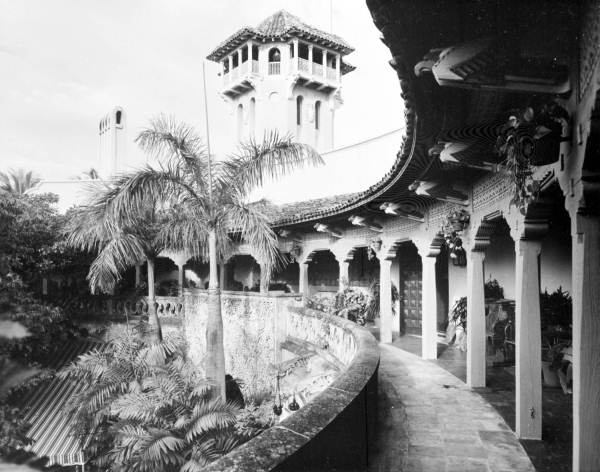In the early 20th century wealthy Northerners who wintered in Florida began building their own estates in towns like Miami. Ft, Lauderdale, and of course, Palm Beach. They needed their own estates because hotels lacked the room to accommodate the large staff of servants necessary to get them through the winter. Besides, private estates allowed more discreet partying during the Prohibition Era. Al Capone chose Miami Beach as the site of his Florida estate. In Palm Beach, Joseph P. Kennedy selected a home on North Ocean Boulevard, which eventually expanded into the Kennedy Compound. It’s still known as that today, though the family sold it in the 1990s. The estates grew larger and more lavish as the wealthy competed with each other to create the most impressive residence, especially in the small and exclusive community of Palm Beach.

Palm Beach also welcomed Anthony Drexel Biddle Jr. and his wife, Mary Duke, who built a sprawling 16,000 square foot home called El Sarmiento. Mary Duke was the heiress to a tobacco fortune. Harold S. Vanderbilt, great-grandson of the Commodore and a noted bon-vivant, purchased a winter home there. Another neighbor, department store heiress Louise Marie Wanamaker and her husband Gurnee Munn, built one for themselves. Yet all of their estates, as well as others built by those of fabulous wealth, were dwarfed by that built by Marjorie Merriweather Post. Her house sat on property connecting the sea to Lake Worth (today part of the Intracoastal Waterway). In Spanish, it ran from Mar (Sea) a Lago (Lake). Here is some of its history, as well as that of the woman who had it built.

1. Marjorie Merriweather Post’s fortune came from the food industry
C. W. Post founded the Post Cereal Company in 1895, manufacturing a breakfast drink mix under the brand name Postum. In 1897, he added Grape-Nuts to his products. In 1904, he introduced his corn flakes under the name, “Elijah’s Manna”. Objections to the sacrilegious nature of the name led him to change it to Post Toasties. Post had one child, daughter Marjorie Merriweather, and little outside interests besides expanding his ever-growing fortune. He survived accusations of product theft from the Kellogg brothers, lawsuits over false advertising, and fought the unionization of his plants. He also invested heavily in Texas real estate.
In 1904, Post divorced his first wife, Marjorie’s mother, and married his secretary. Marjorie remained close to her father. Throughout his life, C. W. suffered from digestive orders causing him great distress and pain (Postum was originally marketed as an easy-to-digest breakfast drink). In 1914, despondent and probably suffering from clinical depression, he committed suicide. His 27-year-old daughter Marjorie inherited his company, as well as a personal fortune of approximately $33 million (roughly $850 million today), as well as several residences. With her husband, Edward Bennett Close, she took over running the company. The Post-Cereal Company continued to expand, introducing new products and absorbing other food companies under Marjorie’s guidance.
